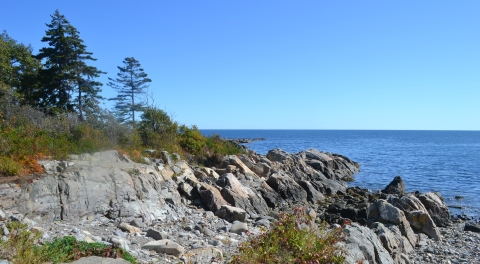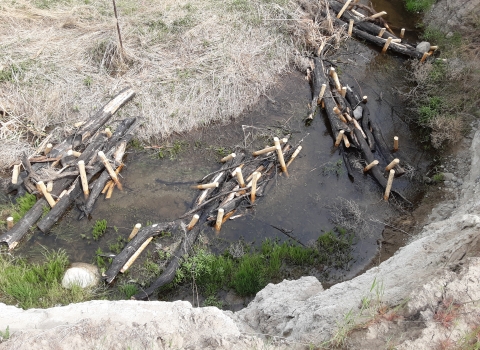Names of southern Maine’s congressional delegation from the past 35 years pepper my conversation with Bill Durkin: Mitchell, Cohen, Allen, Snowe, Collins, Pingree, King. He’s asked them all for money, not for himself, but for a cause much greater: protecting land for wildlife and people in perpetuity.
As board member and president of the Friends of Rachel Carson National Wildlife Refuge, Durkin has long advocated for federal funding to add land to the southern Maine refuge. Through relationships with elected representatives, he and his fellow Friends have helped secure nearly $13 million for land acquisition at the federal refuge since the late 1980s. And with a new visitor center and headquarters on the horizon, opportunities for Durkin and the Friends to support the refuge are expanding.
Speaking for the refuge
A Philadelphia native, Durkin went to college in Maine so he could pursue outdoor passions, such as skiing, hiking and biking. After receiving his master’s degree in environmental education from Antioch University New England, he settled in New Jersey, commuting to work at his family’s travel agency in Philly. But Maine beckoned, and he and his wife moved to Biddeford Pool in the 1980s.
At the time, salt marsh salt marsh
Salt marshes are found in tidal areas near the coast, where freshwater mixes with saltwater.
Learn more about salt marsh habitat in southern Maine was disappearing at a steady pace as demand for vacation homes surged. The Service was looking to add a tenth division — in Biddeford Pool — to Rachel Carson National Wildlife Refuge, and Durkin agreed to represent the division on the Friends board.
He was soon acting as liaison between refuge staff, who identify potential additions to the refuge, and members of Congress, who hand out funds.
“I’d never been involved in a group like that,” Durkin said. “It was an education.”
One of his first lessons? The importance of the Land and Water Conservation Fund, which uses revenues from offshore oil and gas drilling to protect natural areas for the public good. Each year, Congress decides which potential additions to national wildlife refuges, parks and forests receive some of the $900 million allotment.
Refuge Friends groups play a crucial role in communicating with members of Congress about the needs of refuges in their states and districts. Durkin began writing letters to Maine’s delegation, urging them to give Land and Water Conservation funds to Rachel Carson Refuge. Over the years, letters became faxes, and faxes became email messages with PDFs attached.
Durkin built relationships with in-state and Washington, DC, congressional staff and offered testimony to House and Senate committees, both in writing and in person.
"My first hearing felt like Watergate,” he said. “It was in the Rayburn House Office Building, downstairs in one of the big conference rooms. Ashley Judd was testifying in support of protecting wildlife from the effects of climate change climate change
Climate change includes both global warming driven by human-induced emissions of greenhouse gases and the resulting large-scale shifts in weather patterns. Though there have been previous periods of climatic change, since the mid-20th century humans have had an unprecedented impact on Earth's climate system and caused change on a global scale.
Learn more about climate change , and the place was packed with TV cameras and Hollywood photographers. After she finished, everyone left.”
Durkin was there to request $3 million of Land and Water Conservation Fund money for the Service to buy Timber Point, a 97-acre parcel in Biddeford. He got it. The Friends also helped raise more than $2 million to close the deal.
A taste of accomplishment
The Timber Point property is now part of the refuge’s Little River Division. Refuge Manager Karl Stromayer calls it “the most iconic parcel of land in the refuge.”
“It’s beautiful aesthetically and important from a conservation perspective, as it protects the Little River where it flows into the Gulf of Maine,” he said. “It’s a stopover point for migratory birds and has great cultural significance.”
Protecting Timber Point is one of Durkin’s most gratifying achievements.
“There was a big ‘No Trespassing’ sign at the end of the road, and I always wondered what was out there,” he said. “The refuge closed on the property in December, the day before the winter solstice. There was a big storm. I went out in the slashing rain around 5:00 p.m. and ripped that ‘No Trespassing’ sign down. It snowed the next day, and I went cross-country skiing there. The sun was rising, and I was the first one out there. That was a pretty proud moment; I had the classic taste of accomplishment that I was part of the whole process.”
Durkin continues to advocate for the refuge, and the National Wildlife Refuge System as a whole. In May 2023, he submitted written testimony to the Senate Committee on Appropriations requesting $1.6 million from the Land and Water Conservation Fund to conserve vital salt marsh and upland habitat at Rachel Carson, as well as $1.5 billion for operations and maintenance at refuges nationwide.
An expanding role
While land acquisition is still critical, the Friends and the refuge are about to enter an exciting new era, one they’ve dreamed about for three decades.
“The Service recognized southern Maine as a rapidly urbanizing place with lots of visitors and chose our refuge as a strategic place to put a visitor center, even in a time of budget shortages,” Stromayer said.
Thanks in part to advocacy by the Friends, the agency acquired an 11,000-square-foot, stone home in Kennebunk that is being renovated to become a visitor center and headquarters. The facility will have an exhibit hall, a multipurpose room for environmental education programs and events, and office space for Service staff from the refuge and the Gulf of Maine Coastal Program.
The Friends will have an office and nature store in the building. While the group sells refuge-related items on its website to raise funds, reaching an estimated 60,000 refuge visitors annually is on another level.
The opening of the visitor center in 2026 will mark an expansion of the partnership between the refuge and the Friends. The group is looking forward to offering interpretive and recreational programs at the site, which has the makings of a regional and national destination. They plan to help refuge staff design and build an accessible nature trail and explore other possibilities — such as a fishing pier, archery range and kayak launch.
Refuge staff and Friends members recently completed a mentorship program offered by the Service, through which they updated the group’s bylaws and identified shared priorities, such as hiring a volunteer coordinator. A new partnership agreement will broaden the Friends’ role in supporting the refuge.
“Our partnership is evolving and becoming more multifaceted, and we’re excited about having the Friends join us as the face of the refuge,” Stromayer said.
Durkin also looks forward to the next chapter, where the Friends will work side by side with refuge staff, supporting onsite programs and projects, as well as representing the refuge within the community. He’s hoping to recruit new members to the group.
“Friends organizations are vital to the success of refuges,” he said. “We’re the bridge.”






